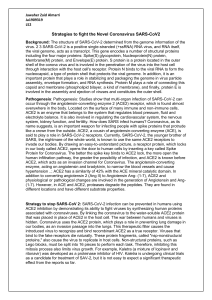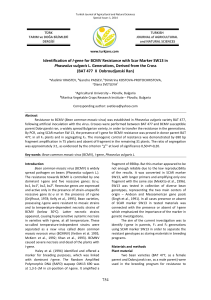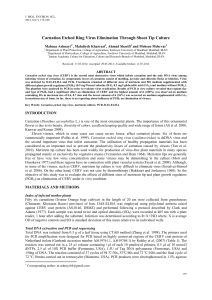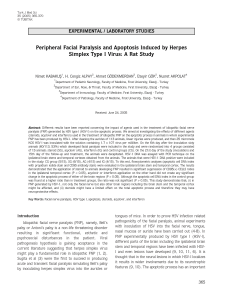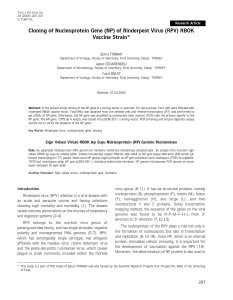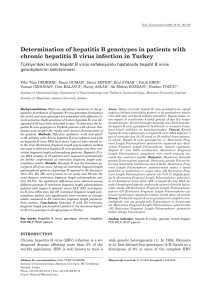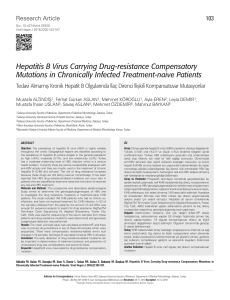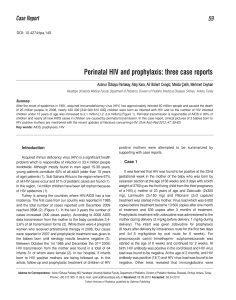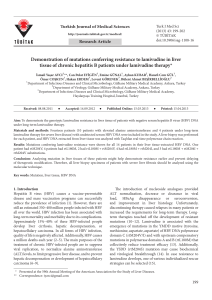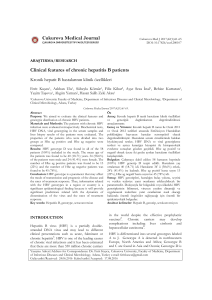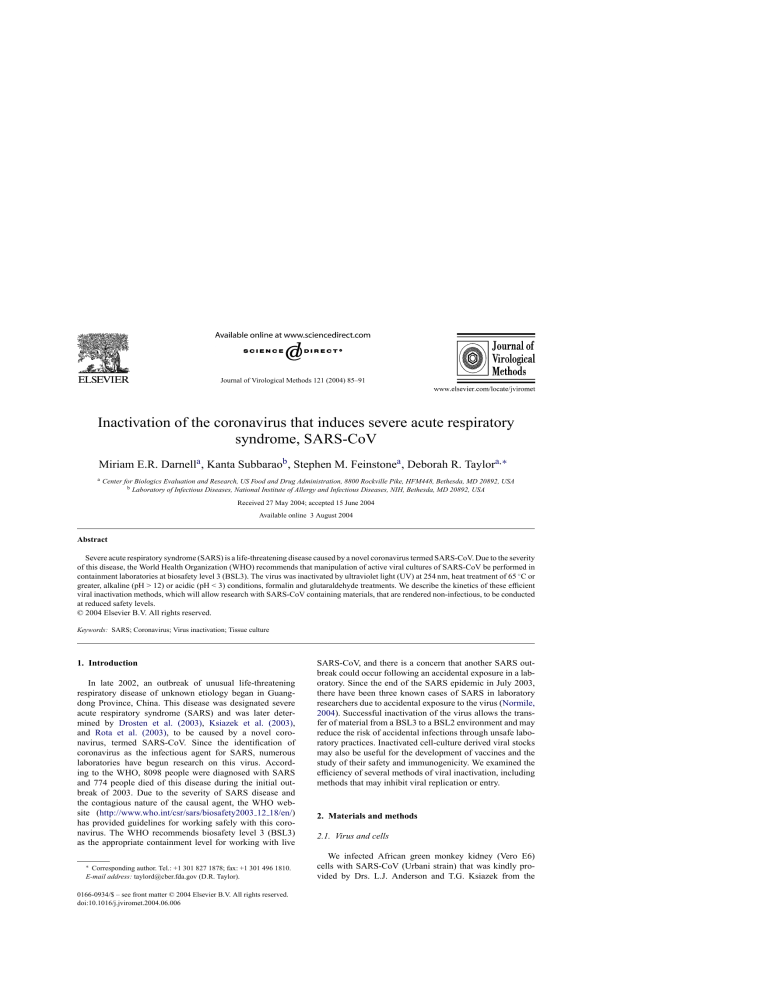
Journal of Virological Methods 121 (2004) 85–91 Inactivation of the coronavirus that induces severe acute respiratory syndrome, SARS-CoV Miriam E.R. Darnella , Kanta Subbaraob , Stephen M. Feinstonea , Deborah R. Taylora,∗ a Center for Biologics Evaluation and Research, US Food and Drug Administration, 8800 Rockville Pike, HFM448, Bethesda, MD 20892, USA b Laboratory of Infectious Diseases, National Institute of Allergy and Infectious Diseases, NIH, Bethesda, MD 20892, USA Received 27 May 2004; accepted 15 June 2004 Available online 3 August 2004 Abstract Severe acute respiratory syndrome (SARS) is a life-threatening disease caused by a novel coronavirus termed SARS-CoV. Due to the severity of this disease, the World Health Organization (WHO) recommends that manipulation of active viral cultures of SARS-CoV be performed in containment laboratories at biosafety level 3 (BSL3). The virus was inactivated by ultraviolet light (UV) at 254 nm, heat treatment of 65 ◦ C or greater, alkaline (pH > 12) or acidic (pH < 3) conditions, formalin and glutaraldehyde treatments. We describe the kinetics of these efficient viral inactivation methods, which will allow research with SARS-CoV containing materials, that are rendered non-infectious, to be conducted at reduced safety levels. © 2004 Elsevier B.V. All rights reserved. Keywords: SARS; Coronavirus; Virus inactivation; Tissue culture 1. Introduction In late 2002, an outbreak of unusual life-threatening respiratory disease of unknown etiology began in Guangdong Province, China. This disease was designated severe acute respiratory syndrome (SARS) and was later determined by Drosten et al. (2003), Ksiazek et al. (2003), and Rota et al. (2003), to be caused by a novel coronavirus, termed SARS-CoV. Since the identification of coronavirus as the infectious agent for SARS, numerous laboratories have begun research on this virus. According to the WHO, 8098 people were diagnosed with SARS and 774 people died of this disease during the initial outbreak of 2003. Due to the severity of SARS disease and the contagious nature of the causal agent, the WHO website (http://www.who.int/csr/sars/biosafety2003 12 18/en/) has provided guidelines for working safely with this coronavirus. The WHO recommends biosafety level 3 (BSL3) as the appropriate containment level for working with live ∗ Corresponding author. Tel.: +1 301 827 1878; fax: +1 301 496 1810. E-mail address: taylord@cber.fda.gov (D.R. Taylor). 0166-0934/$ – see front matter © 2004 Elsevier B.V. All rights reserved. doi:10.1016/j.jviromet.2004.06.006 SARS-CoV, and there is a concern that another SARS outbreak could occur following an accidental exposure in a laboratory. Since the end of the SARS epidemic in July 2003, there have been three known cases of SARS in laboratory researchers due to accidental exposure to the virus (Normile, 2004). Successful inactivation of the virus allows the transfer of material from a BSL3 to a BSL2 environment and may reduce the risk of accidental infections through unsafe laboratory practices. Inactivated cell-culture derived viral stocks may also be useful for the development of vaccines and the study of their safety and immunogenicity. We examined the efficiency of several methods of viral inactivation, including methods that may inhibit viral replication or entry. 2. Materials and methods 2.1. Virus and cells We infected African green monkey kidney (Vero E6) cells with SARS-CoV (Urbani strain) that was kindly provided by Drs. L.J. Anderson and T.G. Ksiazek from the 86 M.E.R. Darnell et al. / Journal of Virological Methods 121 (2004) 85–91 Centers for Disease Control and Prevention, Atlanta, GA. Briefly, Vero E6 monolayer cells were infected by inoculating cultures with 50 l of virus (106.33 TCID50 per ml) in a final volume of 5 ml Dulbecco’s modified Eagle’s medium (DMEM) (Biosource International, Camarillo, CA) in T150 flasks for 1 h at 25 ◦ C. Dulbecco’s modified Eagle’s medium containing supplements (10% fetal bovine serum, 2 mM/ml l-glutamine, 100 U/ml penicillin, 100 g/ml streptomycin, and 0.5 g/ml fungizone) (Biosource International) was added to the flask and the cells were incubated at 37 ◦ C for 3 days. Supernatant was collected, clarified by centrifugation, and stored at −70 ◦ C as the viral stock. The Vero cells were maintained in DMEM with supplements. All personnel wore powered air-purifying respirators (3 M, Saint Paul, MN) and worked with infectious virus inside a biosafety cabinet, within a BSL3 containment facility. 2.2. Quantitation of viral titers Viral titers were determined in Vero cell monolayers on 24 and 96-well plates using a 50% tissue culture infectious dose assay (TCID50 ). Serial dilutions of virus samples were incubated at 37 ◦ C for 4 days and subsequently examined for cytopathic effect (CPE) in infected cells, as described by Ksiazek et al. (2003). Briefly, SARS-CoV-induced CPE of infected cells was determined by observing rounded, detached cells in close association to each other. Evidence of inactivation was determined by absence of CPE in Vero cells, indicating loss of infectivity. 2.3. UV light treatment Ultraviolet light (UV) treatment was performed on 2 ml aliquots of virus (volume depth = 1 cm) in 24-well plates (Corning Inc., Corning, NY). The UV light source (Spectronics Corporation, Westbury, NY) was placed above the plate, at a distance of 3 cm from the bottom of the wells containing the virus samples. At 3 cm our UVC light source (254 nm) emitted 4016 W/cm2 (where W = 10−6 J/s) and the UVA light source (365 nm) emitted 2133 W/cm2 , as measured by radiometric analysis (Spectronics Corporation). After exposure to the UV light source, virus was frozen for later analysis by TCID50 assay using CPE as the endpoint. 2.4. Gamma irradiation treatment We prepared 400 l samples of SARS-CoV and kept them on dry ice during transport. Test samples were subjected to gamma radiation (3000, 5000, 10,000, and 15,000 rad) from a 60 Co source, while control samples were protected from exposure. Test and control samples were handled and transported identically, except test samples were exposed to the gamma radiation source. Samples were kept frozen until analysis of inactivation by TCID50 assay. 2.5. Heat treatment of virus We incubated 320 l aliquots of virus in 1.5 ml polypropylene cryotubes using a heating block to achieve three different temperatures (56, 65 and 75 ◦ C). After heat treatment, samples were frozen for later analysis by TCID50 assay using CPE as an endpoint. 2.6. Formaldehyde and glutaraldehyde treatment Formaldehyde (37%, Mallinckrodt Baker, Inc., Paris, KY) and glutaraldehyde (8%, Sigma, Saint Louis, MO) were diluted 1:10 and 1:40 in sterile PBS. These diluted aldehydes were added to virus samples to achieve final dilutions of 1:1000 and 1:4000 in 400 l. The final concentrations of formaldehyde were 0.037% (1:1000) and 0.009% (1:4000), and the final concentrations of glutaraldehyde were 0.008% (1:1000) and 0.002% (1:4000). The virus and aldehyde samples were incubated at 4, 25, and 37 ◦ C, for up to 3 days. The samples were mixed briefly with a vortex on each day. The samples were stored at −70 ◦ C until analysis by TCID50 assay. 2.7. pH treatment Virus aliquots were adjusted to the desired pH using 5 M and 1 M HCl or 5N and 1N NaOH. Subsequently, they were divided into three aliquots, incubated at the desired temperature (4, 25, and 37 ◦ C), neutralized to a pH 7, and analyzed for viral titer using the TCID50 assay. 2.8. Infectivity of viral RNA and detergent-disrupted virions Infected Vero cells were prepared by inoculation with 20 l of virus at a 106.37 TCID50 per ml of SARS-CoV in a final volume of 2 ml in a T25 flask for 1 h at 25 ◦ C. DMEM with supplements was added to the flask and the cells were incubated at 37 ◦ C for 3 days. The monolayer was washed with 1X phosphate buffered saline (PBS), cells were lysed with the addition of 2.5 ml of a phenol and guanidine isothiocyanate solution (TRIzol Reagent, Sigma), and cytoplasmic RNA was isolated according to the manufacturer’s specifications. Vero cells were inoculated with 10 l of purified RNA in 0.5 ml DMEM. After an hour, DMEM with supplements was added. Additionally, Vero cells were transfected with cytoplasmic RNA using DMRIE-C (Invitrogen Life Technologies, Carlsbad, CA) according to the manufacturer’s instructions. Cells were incubated at 37 ◦ C, and observed for CPE on days 3 and 4. To examine the infectivity of detergent-disrupted virions, SARS-CoV infected Vero monolayer cells were washed and dissociated with trypsin/versene, pelleted by centrifugation, and washed with PBS. After centrifugation, the pellet was lysed with sodium dodecyl sulfate/nonidet P-40 (SDS/NP40; 0.1% SDS, 0.1% NP-40, in 0.1x PBS; Sigma), frozen M.E.R. Darnell et al. / Journal of Virological Methods 121 (2004) 85–91 87 at −70 ◦ C, thawed, and clarified by centrifugation. The supernatant was used to infect Vero cell monolayers in 6-well plates, such that the final concentration of SDS was 0.002 or 0.018%. Three and four days following the inoculation, cells were observed for evidence of CPE. 3. Results 3.1. Effect of radiation on the infectivity of SARS-CoV UV light is divided into three classifications: UVA (320–400 nm), UVB (280–320 nm), and UVC (200–280 nm). UVC is absorbed by RNA and DNA bases, and can cause the photochemical fusion of two adjacent pyrimidines into covalently linked dimers, which then become non-pairing bases (Perdiz et al., 2000). UVB can cause the induction of pyrimidine dimers, but 20–100-fold less efficiently than UVC (Perdiz et al., 2000). UVA is weakly absorbed by DNA and RNA, and is much less effective than UVC and UVB in inducing pyrimidine dimers, but may cause additional genetic damage through the production of reactive oxygen species, which cause oxidization of bases and strand breaks (Tyrrell et al., 2001). To examine the inactivation potential of UVA and UVC, virus stocks were placed in 24-well tissue culture plates and exposed to UV irradiation on ice for varying amounts of time, as indicated in Fig. 1A. Exposure of virus to UVC light resulted in partial inactivation at 1 min with increasing efficiency up to 6 min (Fig. 1A), resulting in a 400-fold decrease in infectious virus. No additional inactivation was observed from 6 to 10 min. After 15 min the virus was completely inactivated to the limit of detection of the assay, which is ≤1.0 TCID50 (log10 ) per ml. In contrast, UVA exposure demonstrated no significant effects on virus inactivation over a 15 min period. Our data show that UVC light inactivated the SARS virus at a distance of 3 cm for 15 min. A standard procedure to inactivate viruses during the manufacture of biological products is gamma irradiation (Grieb et al., 2002). To investigate the effect of gamma irradiation on SARS-CoV, we subjected 400 l of SARS-CoV to gamma radiation (3000, 5000, 10,000, and 15,000 rad) from a 60 Co source, while control samples were protected from exposure. No effect on viral infectivity was observed within this range of gamma irradiation exposure (Fig. 1B). 3.2. Effect of heat treatment on the infectivity of SARS-CoV Heat can inactivate viruses by denaturing the secondary structures of proteins, and thereby may alter the conformation of virion proteins involved in attachment and replication within a host cell (Lelie et al., 1987; Schlegel et al., 2001). To test the ability of heat to inactivate the SARS-CoV, we incubated virus in 1.5 ml polypropylene cryotubes at three temperatures (56, 65 and 75 ◦ C) for increasing periods of time. Fig. 1. Effect of radiation on the infectivity of SARS-CoV. (A) UV irradiation. The UV lamp was placed 3 cm above the bottom of 24-well plates containing 2 ml virus aliquots. Samples were removed at each time point, frozen, and titrated in Vero E6 cells. The results shown are representative of three independent experiments. (B) Gamma irradiation. Virus aliquots (400 l) were placed in cryovials on dry ice and exposed to the indicated dose of gamma irradiation. Control samples were treated identically, without radiation exposure. Samples were titrated in Vero E6 cells in triplicate. The dotted line denotes the limit of detection of the assay. We found that at 56 ◦ C most of the virus was inactivated after 20 min (Fig. 2A). However, the virus remained infectious at a level close to the limit of detection for the assay, for at least 60 min, suggesting that some virus particles were stable at 56 ◦ C (Fig. 2A and C). At 65 ◦ C, most of the virus was inactivated if incubated for longer than 4 min (Fig. 2B). Again, some infectious virus could still be detected close to the limit of detection for the assay, after 20 min at 65 ◦ C. While virus was incompletely inactivated at 56 and 65 ◦ C even at 60 min, it was completely inactivated at 75 ◦ C in 45 min (Fig. 2C). Surprisingly, at both 56 and 65 ◦ C the virus was inactivated at early time points but at 60 min a small amount of virus was detected. One possible explanation for this result may be the presence and subsequent dissociation of aggregates. Taken together, these results suggest that viral inactivation by pasteurization may be very effective. 3.3. Effects of formaldehyde and glutaraldehyde on the infectivity of SARS-CoV Formalin (dilute formaldehyde) has been used for a number of years to inactivate virus for use in vaccine products, such as the widely used and very effective polio vaccine (Salk and Salk, 1984). Other attempts at using formalin inactivation for generation of vaccines for respiratory syncytial virus (Kim ≤1.0 ≤1.0 ≤1.0 2.78 ± 0.14 ≤1.0 ≤1.0 ≤1.0 4.1 ± 0.52 ≤1.0 ≤1.0 2.19 ± 0.25 5.12 ± 0.14 ≤1.0 ≤1.0 ≤1.0 3.36 ± 0.29 c a b Formaldehyde treatment fixed the cells in the TCID50 assay so virus could not be detected. Geometric mean of triplicate samples ± S.D. The limit of detection for the TCID50 assay is ≤1.0. ≤1.0 ≤1.0 ≤1.0 4.86 ± 0.29 ≤1.0 ≤1.0 2.26 ± 0.38 5.03 ± 0.14 ≤1.0 ≤1.0 ≤1.0 4.03 ± 0.14 ≤1.0c ≤1.0 2.70 ± 0 5.28 ± 0.29 Glutaraldehyde treatment No 1:1000 Yes 1:1000 Yes 1:4000 Yes No ≤1.0 ≤1.0 1.31 ± 0.29 5.09 ± 0.58 x x 1.14 ± 0.29 x x 3.28 ± 0.14 x x 1.5 ± 0 x x 1.31 ± 0.29 x x 4.02 ± 0.38 x x 1.31 ±0.29 x x 1.31 ± 0.29 xa x 4.45 ± 0.25b Formaldehyde treatment No 1:1000 Yes 1:1000 Yes 1:4000 25 ◦ C 4 ◦C Day 3 37 ◦ C 25 ◦ C 4 ◦C 37 ◦ C 25 ◦ C 4 ◦C Day 1 Dilution Virus Table 1 Effect of formaldehyde and glutaraldehyde inactivation of SARS-CoV et al., 1969) and measles virus (Fulginiti et al., 1967) were not useful, as they induced an aberrant immune response resulting from formalin-induced perturbations of the viruses. Formalin inactivation occurs when nonprotonated amino groups of amino acids, such as lysine, combine with formaldehyde to form hydroxymethylamine. The hydroxymethylamine combines with the amino, amide, guanidyl, phenolic, or imidazole group of amino acids to create inter- or intramolecular methylene crosslinks (for review, see Jiang and Schwendeman, 2000). Fraenkel-Conrat (1954) observed the absorption spectra of several plant viruses and determined that formalin also binds in a reversible manner to RNA, blocking reading of the genome by RNA polymerase. Glutaraldehyde can also be used to inactivate virus and is used as a disinfecting agent of medical instruments, such as endoscopes (Tandon, 2000), and as a fixative for electron microscopy (McDonnell and Russell, 1999). We examined formalin and glutaraldehyde inactivation of the SARS-CoV by incubating virus samples with formalin or glutaraldehyde at two different dilutions (1:1000 and 1:4000). Each of the diluted aldehydes was incubated with virus at 4, 25 or 37 ◦ C. Both of the aldehydes exhibited temperature de- Day 2 Fig. 2. Effect of heat treatment on the infectivity of SARS-CoV. Virus aliquots (400 l) were incubated at (A, C) 56 ◦ C, (B, C) 65 ◦ C and (C) 75 ◦ C. Samples were removed at the designated time, frozen, and titrated in Vero E6 cells in triplicate. The dotted line denotes the limit of detection of the assay. x x 1.14 ± 0.29 M.E.R. Darnell et al. / Journal of Virological Methods 121 (2004) 85–91 37 ◦ C 88 M.E.R. Darnell et al. / Journal of Virological Methods 121 (2004) 85–91 pendence in their ability to inactivate virus (Table 1). Neither formalin nor glutaraldehyde, at a 1:4000 dilution, was able to completely inactivate virus at 4 ◦ C, even after exposure for 3 days (Table 1). At 25 and 37 ◦ C, formalin inactivated most of the virus, close to the limit of detection of the assay, after 1 day, yet some virus still remained infectious on day 3. However, glutaraldehyde completely inactivated the virus by day 2 at 25 ◦ C and by day 1 at 37 ◦ C. This suggests that both formalin and glutaraldehyde inactivation of SARS virus may be efficient methods of inactivation, if proper conditions are met. 3.4. Effect of pH changes on the infectivity of SARS Weismiller et al. (1990) determined that a pH of 8.0 induces a conformational change in the spike protein of the coronavirus, mouse hepatitis virus (MHV), which enables fusion of the virion with the host cell. However, Xiao et al. (2003) determined that the spike protein of SARS-CoV mediated fusion with the host cell at a neutral pH. These data suggest that different pH conditions affect the spike proteins of coronaviruses, and the activity of the spike protein of the SARS-CoV may be sensitive to changes in pH, possibly by changing the infectious nature of the viral particles. Therefore, we investigated the effect of different pH exposures on the infectivity of SARS-CoV. After exposing SARS-CoV to extreme alkaline conditions of pH 12 and 14 for 1 h, and subsequently reversing the conditions to a neutralized, buffered solution, the virus was completely inactivated (Fig. 3). Moderate variations of pH conditions from 5 to 9 had little effect on virus titer, regardless of the temperature. However, highly acidic pH conditions of 1 and 3 completely inactivated the virus at 25 and 37 ◦ C. At 4 ◦ C, a pH of 3 did not fully inactivate the virus. These data indicate that the infectivity of SARS-CoV is sensitive to pH extremes. 3.5. Infectivity of isolated viral RNA and isolated proteins Biochemical and molecular biology experiments may require the isolation of nucleic acids or proteins from virus- Fig. 3. Effect of pH conditions on the infectivity of SARS-CoV. Virus aliquots (2 ml) were adjusted to the indicated pH condition, divided into triplicate samples, incubated at the designated temperature for 1 h, neutralized, frozen, and titrated. The dotted line denotes the limit of detection of the assay. 89 infected cells. We used a phenol and guanidine isothiocyanate solution (TRIzol, Sigma) to isolate cytoplasmic RNA from SARS-CoV infected Vero cells. After inoculation of Vero cells with the isolated RNA, we determined that SARS-CoV RNA was not able to produce CPE in the cells (data not shown). We also found that transfection of the cells with this RNA, using a liposome-based transfection reagent (DMRIEC, Invitrogen, as per manufacturer’s instructions for RNA transfection), was also not sufficient to cause infection of Vero cells (data not shown). Additionally, we tested the effectiveness of SDS/NP-40 treatment on inactivation of the SARS-CoV. Briefly, SARSCoV-infected Vero cells were lysed with an SDS/NP-40 solution, clarified by centrifugation, and the supernatant was used to infect Vero cell monolayers. No CPE was observed in the cells after 3 and 4 days, indicating that SDS/NP-40-induced disruption of the virions was sufficient to prevent survival of infectious particles. 4. Discussion Inactivation of SARS-CoV can be achieved through a number of techniques, given sufficient time and appropriate temperature conditions. We caution that the inactivation procedures discussed above were performed under specific conditions. Due to the grave consequences of a potential SARS-CoV human infection, great care should be taken to ensure that any inactivation procedures used to make the virus safe for BSL2 conditions are effective for each viral stock. We determined that greater than 15 min of UVC treatment inactivated the virus while UVA light had no effect on viability, regardless of duration of exposure. Duan et al. (2003) examined the effect of UVC light on SARS-CoV at an intensity of >90 W/cm2 and a distance of 80 cm, and determined that inactivation of the virus occurred at 60 min. Inactivation may have occurred more efficiently in our study due to the greater intensity of UVC light and the closer proximity of the light source. We also examined the effect of gamma irradiation on SARS-CoV, and found no decrease in infectivity at the highest dose of 15,000 rad. This result was not surprising, as the Centers for Disease Control and Prevention have used a much higher dose of 2 × 106 rad to inactivate potential SARS-CoV-infected serum specimens for study in BSL2 laboratories (Ksiazek et al., 2003). This dosage is in the same range (3–4.5 × 106 rad) that is necessary to inactivate viruses in monoclonal antibody preparations (Grieb et al., 2002) and bone diaphysis transplants (Pruss et al., 2002). Our experiments showed that heat treatment of SARSCoV for 45 min at 75 ◦ C resulted in inactivation of the virus, while 90 min at 56 and 65 ◦ C was required for virus inactivation. Laude (1981) determined that thermal inactivation of another coronavirus, transmissible gastroenteritis virus of swine, also occurred faster at higher temperatures, such as 47 and 55 ◦ C, than at the lower temperature of 31 ◦ C. Our data are similar to the findings of Duan et al. (2003), wherein viral 90 M.E.R. Darnell et al. / Journal of Virological Methods 121 (2004) 85–91 inactivation occurred at 90, 60, and 30 min after incubation at 56, 65, and 75 ◦ C, respectively. Heat is an effective means of SARS-CoV inactivation, however, stocks containing viral aggregates may require a longer duration of heat exposure. We determined that formalin and glutaraldehyde inactivated SARS-CoV in a temperature- and time-dependent manner. While incubation at 4 ◦ C inhibited the effect of these chemicals, at 37 ◦ C or room temperature, formalin significantly decreased the infectivity of the virus on day 1, while glutaraldehyde inactivated SARS-CoV after incubations of 1–2 days. As glutaraldehyde is commonly used to disinfect medical instruments, especially endoscopes, care should be taken to analyze time, temperature, and concentration requirements necessary for complete SARS-CoV inactivation. Weismiller et al. (1990) determined that a pH of 8.0 induces a conformational change in the spike protein of the coronavirus MHV that enables fusion of the virion with the host cell. However, Xiao et al. (2003) determined that the spike protein of SARS-CoV mediated fusion with the host cell at a neutral pH. These data suggest that different pH conditions affect the spike proteins of coronaviruses, and the activity of the spike protein of SARS-CoV may be sensitive to changes in pH, possibly by changing the infectious nature of the viral particles. We determined that exposure of SARS-CoV to extreme basic or acidic conditions caused inactivation, while the virus remained stable within a range of neutral pH. The pH of gastric secretions of the stomach ranges from 1.0 to 3.5, while the small and large intestines range from pH 7.5 to 8.0 (Guyton and Hall, 1997). Taken together, these data suggest that ingestion of SARS-CoV would probably result in inactivation of most virions by stomach acid. However, acidic conditions of the stomach may be partially neutralized by a particularly large meal or antacid ingestion, and under these conditions the virus might have a chance to move through the stomach into the slightly basic conditions of the intestines. Leung et al. (2003) have shown enteric involvement of the SARS virus, as evidenced by the presence of active viral replication in intestinal biopsy specimens from five patients, and the isolation of SARS-CoV RNA in stool specimens up to 10 weeks after onset of symptoms. These data, coupled with the previously mentioned stability of the virus to moderate pH conditions, suggest that the SARS virus may survive ingestion and a fecal/oral route of infection may be possible. Our experiments showed that UVC light, heat, formalin, glutaraldehyde, and extremes of pH, were able to inactivate SARS-CoV. However, gamma irradiation at the doses tested, was not sufficient to inactivate the virus. As expected, neither viral RNA alone nor virions disrupted by SDS/NP-40 were infectious. These conditions were appropriate for our viral stocks as described, however, we caution that researchers need to test viral stocks for complete inactivation before handling the virus at lower safety levels. These data analyze virus samples in tissue culture medium and we are currently testing the inactivation properties required of SARS-CoV in biological (body) fluids. Understanding the ways in which SARS- CoV can be inactivated, will allow the transfer of the virus from BSL3 to BSL2 conditions, and will promote the study of inactivated viral vaccines. Acknowledgements We thank Spectronics Corporation for the use of UV lamps and radiometer. We also thank Leatrice Vogel and Josephine McAuliffe for technical assistance, Montserrat Puig for helpful suggestions and Kathryn Carbone, Jesse Goodman, Bill Egan and Jerry Weir for their support. References Drosten, C., Gunther, S., Preiser, W., van der Werf, S., Brodt, H.-R., Becker, S., Rabenau, H., Panning, M., Kolesnikova, L., Fouchier, R.A.M., Berger, A., Burguiere, A.-M., Cinatl, J., Eickmann, M., Escriou, N., Grywna, K., Kramme, S., Manuguerra, J.-C., Muller, S., Rickerts, V., Sturmer, M., Vieth, S., Klenk, H.-D., Osterhaus, A.D.M.E., Schmitz, H., Doerr, H.W., 2003. Identification of a novel coronavirus in patients with severe acute respiratory syndrome. N. Engl. J. Med. 348, 1967–1976. Duan, S.-M., Zhao, X.-S., Wen, R.-F., Huang, J.-J., Pi, G.-H., Zhang, S.-X., Han, J., Bi, S.-L., Ruan, L., Dong, X.-P., and SARS Research Team, 2003. Stability of SARS coronavirus in human specimens and environment and its sensitivity to heating and UV irradiation. Biomed. Environ. Sci. 16, 246–255. Fraenkel-Conrat, H., 1954. Reaction of nucleic acid with formaldehyde. Biochim. Biophys. Acta 15, 307–309. Fulginiti, V.A., Eller, J.J., Downie, A.W., Kempe, C.H., 1967. Altered reactivity to measles virus: atypical measles in children previously immunized with inactivated measles virus vaccines. JAMA 202, 1075–1080. Grieb, T., Forng, R.-Y., Brown, R., Owolabi, T., Maddox, E., McBain, A., Drohan, W.N., Mann, D.M., Burgess, W.H., 2002. Effective use of gamma irradiation for pathogen inactivation of monoclonal antibody preparations. Biologicals 30, 207–216. Guyton, A.C., Hall, J.E., 1997. Secertory fuction of the alimentary tract. Human Physiology and Mechanisms of Disease, sixth ed. W.B. Saunders Company, Philadelphia (pp. 524–536). Jiang, W., Schwendeman, S.P., 2000. Formaldehyde-mediated aggregation of protein antigens: comparison of untreated and formalinized model antigens. Biotechnol. Bioeng. 70, 507–517. Kim, H.W., Canchola, J.G., Brandt, C.D., Pyles, G., Chanock, R.M., Jensen, K., Parrott, R.H., 1969. Respiratory syncytial virus disease in infants despite prior administration of antigenic inactivated vaccine. Am. J. Epidemiol. 89, 422–434. Ksiazek, T.G., Erdman, D., Goldsmith, C.S., Zaki, S.R., Peret, T., Emery, S., Tong, S., Urbani, C., Comer, J.A., Lim, W., Rollin, P.E., Dowell, S.F., Ling, A.-E., Humphrey, C.D., Shieh, W.-J., Guarner, J., Paddock, C.D., Rota, P., Fields, B., DeRisi, J., Yang, J.-Y., Cox, N., Hughes, J.M., LeDuc, J.W., Bellini, W.J., Anderson, L.J., and the SARS Working Group, 2003. A novel coronavirus associated with severe acute respiratory syndrome. N. Engl. J. Med. 348, 1953– 1966. Laude, H., 1981. Thermal inactivation studies of a coronavirus, transmissible gastroenteritis virus. J. Gen. Virol. 56, 235–240. Lelie, P.N., Reesink, H.W., Lucas, C.J., 1987. Inactivation of 12 viruses by heating steps applied during manufacture of a hepatitis B vaccine. J. Med. Virol. 23, 297–301. Leung, W.K., To, K.-F., Chan, P.K.S., Chan, H.L.Y., Wu, A.K.L., Lee, N., Yuen, K.Y., Sung, J.J.Y., 2003. Enteric involvement of severe acute M.E.R. Darnell et al. / Journal of Virological Methods 121 (2004) 85–91 respiratory syndrome-associated coronavirus infection. Gastroenterology 125, 1011–1017. McDonnell, G., Russell, A.D., 1999. Antiseptics and disinfectants: activity, action, and resistance. Clin. Micro. Rev. 12, 147–179. Normile, D., 2004. Mounting lab accidents raise SARS fears. Science 304, 659–661. Perdiz, D., Grof, P., Mezzina, M., Nikaido, O., Moustacchi, E., Sage, E., 2000. Distribution and repair of bipyrimidine photoproducts in solar UV-irradiated mammalian cells. J. Biol. Chem. 275, 26732– 26742. Pruss, A., Kao, M., Gohs, U., Koscielny, J., von Versen, R., Pauli, G., 2002. Effect of gamma irradiation on human cortical bone transplants contaminated with enveloped and non-enveloped viruses. Biologicals 30, 125–133. Rota, P.A., Oberste, M.S., Monroe, S.S., Nix, W.A., Campagnoli, R., Icenogle, J.P., Penaranda, S., Bankamp, B., Maher, K., Chen, M.H., Tong, S., Tamin, A., Lowe, L., Frace, M., DeRisi, J.L., Chen, Q., Wang, D., Erdman, D.D., Peret, T.C.T., Burns, C., Ksiazek, T.G., Rollin, P.E., Sanchez, A., Liffick, S., Holloway, B., Limor, J., McCaustland, K., Olsen-Rasmussen, M., Fouchier, R., Gunther, S., Oster- 91 haus, A.D.M.E., Drosten, C., Pallansch, M.A., Anderson, L.J., Bellini, W.J., 2003. Characterization of a novel coronavirus associated with severe acute respiratory syndrome. Science 300, 1394–1399. Salk, D., Salk, J., 1984. Vaccinology of poliomyelitis. Vaccine 2, 59–74. Schlegel, A., Immelmann, A., Kempf, C., 2001. Virus inactivation of plasma-derived proteins by pasteurizaion in the presence of guanidine hydrochloride. Transfusion 41, 382–389. Tandon, R.K., 2000. Disinfection of gastrointestinal endoscopes and accessories. J. Gastroenterol. Hepatol. 15, 69–72. Tyrrell, J.-L., Douki, T., Cadet, J., 2001. Direct and indirect effects of UV radiation on DNA and its components. J. Photochem. Photobiol. B 63, 88–102. Weismiller, D.J., Sturman, L.S., Buchmeier, M.J., Fleming, J.O., Holmes, K.V., 1990. Monoclonal antibodies to the peplomer glycoprotein of coronavirus mouse hepatitis virus identify two subunits and detect a conformational change in the subunit released under mild alkaline conditions. J. Virol. 64, 3051–3055. Xiao, X., Chakraborti, S., Dimitrov, A.S., Gramatikoff, K., Dimitrov, D.S., 2003. The SARS-CoV S glycoprotein: expression and functional characterization. Biochem. Biophys. Res. Commun. 312, 1159–1164.
